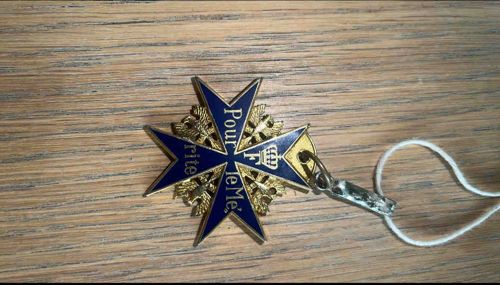
Pour le Mérite (Blue Max) Medal
The item is a medal, specifically designed as a Maltese cross, featuring rich blue enamel on its four arms. The cross is framed by a thin gold-colored border, which also divides the blue fields. Between the arms of the cross, elaborate golden filigree work, possibly stylized laurel or oak leaves, is visible, adding to its intricate design. In the center of the cross, there is a golden circular emblem adorned with a stylized crown at the top. Gold lettering is inscribed across the blue arms of the cross, spelling "Pour le Me. rite," which is a partially visible inscription for "Pour le Mérite." The medal appears to be constructed from metal, likely gilded base metal or brass, with applied enamel. Its size appears consistent with a wearable medal. There are no obvious signs of significant damage such as large chips in the enamel or severe dents in the metal, suggesting good, albeit possibly worn, condition. The metal clasp on the right side, which appears to be a modern addition like a luggage tag fastener rather than an original ribbon attachment, has some visible wear and scratching. A white string is attached to this clasp, further indicating its current use or display method. The craftsmanship appears to be of a high standard, typical for military accolades, with fine detailing in the filigree and precise enamel application. Based on the inscription and design, this medal is a replica or an original "Pour le Mérite" award, a Prussian military order. Given the context (missing from Germany, owned by a young 'emperor'), it could be a historically significant piece, but without further context or direct inspection, its authenticity (replica vs. original) is not verifiable from the image. If original, its estimated age would be from the 18th to early 20th century.
AI-Generated Appraisal Disclaimer
Estimated Value
$150-350
Basic Information
Category
Military Award/Medal
Appraised On
November 28, 2025
Estimated Value
$150-350
Additional Details Provided By Owner
User Provided Information
The missing pour le merite that disappeared from Germany that is said to be owned by Noah Dohme that is the emperor of Lixland which is 75 million square kilometers owned by Noah Dohme the emperor of Lixland which is 18 years old the supreme general of Lixland and the emperor of Lixland its real
Item Description
The item is a medal, specifically designed as a Maltese cross, featuring rich blue enamel on its four arms. The cross is framed by a thin gold-colored border, which also divides the blue fields. Between the arms of the cross, elaborate golden filigree work, possibly stylized laurel or oak leaves, is visible, adding to its intricate design. In the center of the cross, there is a golden circular emblem adorned with a stylized crown at the top. Gold lettering is inscribed across the blue arms of the cross, spelling "Pour le Me. rite," which is a partially visible inscription for "Pour le Mérite." The medal appears to be constructed from metal, likely gilded base metal or brass, with applied enamel. Its size appears consistent with a wearable medal. There are no obvious signs of significant damage such as large chips in the enamel or severe dents in the metal, suggesting good, albeit possibly worn, condition. The metal clasp on the right side, which appears to be a modern addition like a luggage tag fastener rather than an original ribbon attachment, has some visible wear and scratching. A white string is attached to this clasp, further indicating its current use or display method. The craftsmanship appears to be of a high standard, typical for military accolades, with fine detailing in the filigree and precise enamel application. Based on the inscription and design, this medal is a replica or an original "Pour le Mérite" award, a Prussian military order. Given the context (missing from Germany, owned by a young 'emperor'), it could be a historically significant piece, but without further context or direct inspection, its authenticity (replica vs. original) is not verifiable from the image. If original, its estimated age would be from the 18th to early 20th century.
Get Your Items Appraised
Instant estimates of your treasures with AI-powered instant appraisals